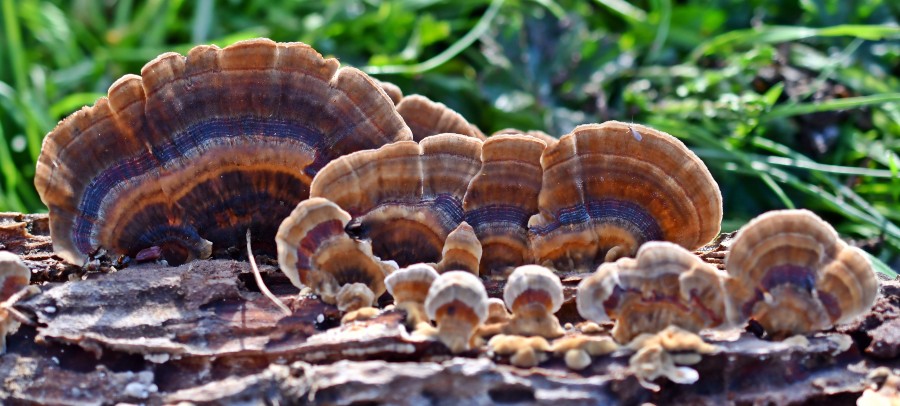Some mushrooms are highly sought-after for their use in cooking. Others get used for their medicinal benefits.
Turkey tail mushrooms fall into the second category. They contain a number of beneficial compounds that make them worth consuming.
The problem is that you can’t simply eat turkey tail mushrooms like portobellos or oyster mushrooms. Their thick and woody structure makes them basically inedible to humans.
These mushrooms need to get prepared in specific ways if you want to benefit from them.
The good news is that preparing turkey tail mushrooms as a tea or supplement isn’t difficult.
In this article we’ll explain how you can use turkey tails for medicinal use. We’ll also go over how to find and identify them, what their benefits are and more. Keep reading to see if turkey tail mushrooms are something you might want to add to your daily health regimen.
And if you’re in the UK I’d love you to have a look at our MycoTonics range of medicinal extracts which includes Turkey Tail.
What Are Turkey Tail Mushrooms?
Turkey tail mushrooms are a type of polypore mushroom that you can find all around the world.
A polypore is a type of mushroom that has pores on its underside. As opposed to the gills that you find on most mushrooms. Most commonly, these are shelf or bracket fungi that grow on living or dead trees. Usually they are tough and inedible, but may still contain beneficial compounds.
The turkey tail mushroom actually has three separate scientific names. Depending on who is describing them and how they choose to classify these mushrooms, you may hear any of these names used. They include Trametes versicolor, Coriolus versicolor and Polyporus versicolor.
The “versicolor” part of the name describes how the turkey tail mushroom usually displays several colors. The cap of this mushroom can have rings of different colors including white, various shades of red and orange, all the way to dark brown.
The way that groups of turkey tail mushrooms grow together in a cluster, combined with their coloration, is where the name comes from. The mushrooms look similar to the tail of a wild turkey in both shape and color.
The use of turkey tail mushrooms goes back centuries. Like most medicinal mushrooms, the oldest references to it come from traditional Chinese medicine. Originally it was used for treating respiratory problems, as well as issues with the liver and spleen.
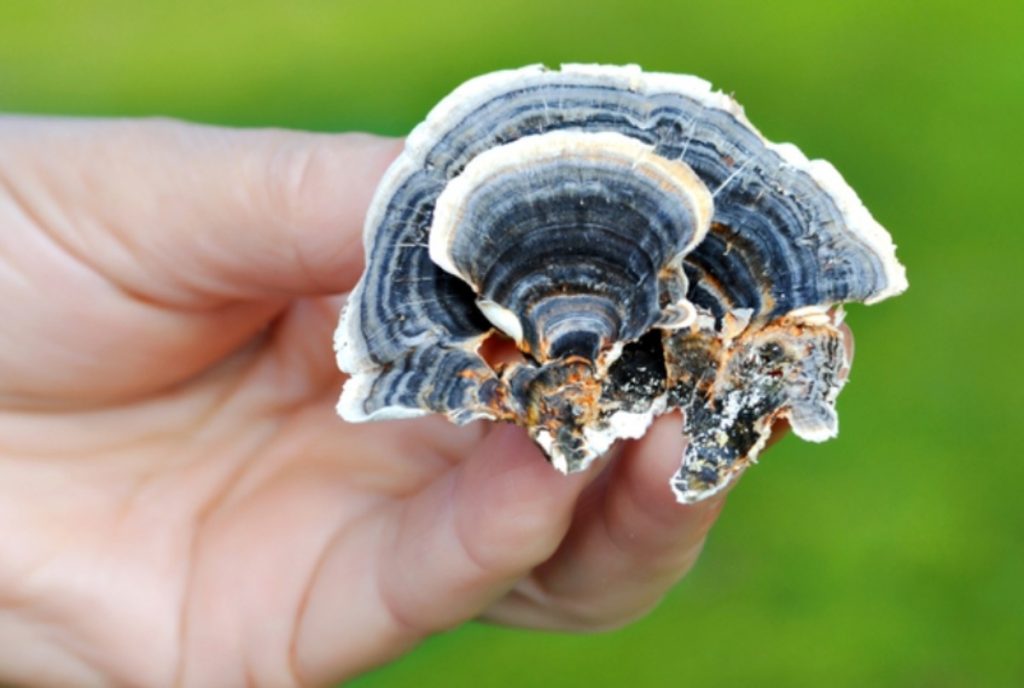
What Do Turkey Tail Mushrooms Look Like?
The caps of turkey tail mushrooms are about 0.7 to 3 inches (2 to 8 cm) across. They are quite thin at only 0.04 to 0.08 inches (1 to 2 mm) in thickness. Depending on how mature the mushrooms are, the cap may be convex or flat.
Turkey tail caps can come in a variety of shapes. These include kidney-shaped, circular, semi-circular, bracket-shaped or fan-shaped.
When the caps are young and fresh they are flexible, although they quickly dry out and become brittle. They can feel velvety or even hairy in texture.
The colors of the turkey tail mushroom form in concentric rings, similar to the rings of a tree trunk.
You will most often see turkey tails that feature various shades of white, brown, red, orange, cinnamon and grey. However you may also see hues of green and blue sometimes.
The color of these mushrooms is highly variable, so color shouldn’t be your only identifying characteristic.
Underneath a turkey tail cap, the pore surface can vary from white to a pale brown color. The entire underside is covered in tiny pores. A one inch (2.5 cm) area can have anywhere from 75 to 150 pores.
Turkey tail mushrooms thrive outdoors. See our article How To Grow Mushrooms Outdoors With A Mushroom Bed for more information on growing mushrooms outside.
Are Turkey Tail Mushrooms Poisonous?
Turkey tail mushrooms are not poisonous. The good news is that they don’t have any known poisonous look-alikes either.
This makes harvesting and consuming them pretty low-risk. Worst case, you might get the wrong species that has an unpleasant taste. Or one that doesn’t provide any of the medicinal benefits that you’re expecting. But turkey tails and its look-alikes won’t make you sick.
That being said, turkey tail mushrooms aren’t really edible either. They are extremely tough and woody. So you wouldn’t want to eat them even after cooking them thoroughly.
Instead, turkey tail mushrooms are most commonly dried and ground into a powder. We will discuss exactly how to take this powder a bit later.
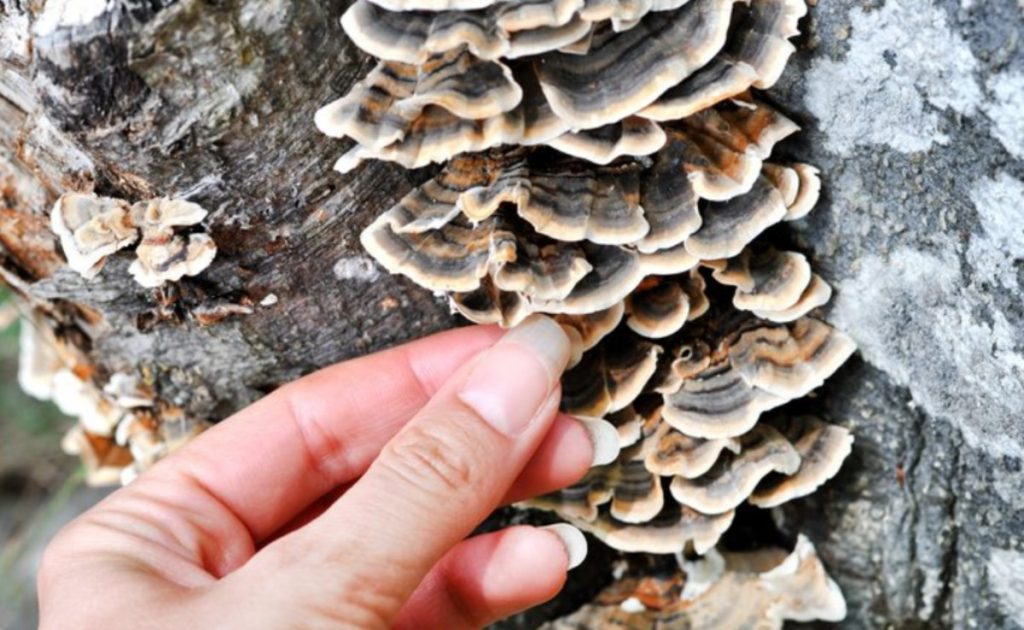
What Is Turkey Tail Mushroom Good For?
Turkey tail mushroom benefits cover a wide range of ailments. Ranging from minor complaints, all the way up to serious conditions like cancer.
These mushrooms contain a wide range of antioxidants called flavonoids and phenols that can help to boost your immune system. They accomplish this by reducing inflammation in the body as well as helping to stimulate your body’s natural production of its own protective compounds.
Turkey tail mushrooms can also improve the health of your gut. Turkey tail mushrooms contain helpful prebiotics that can help to suppress bad bacteria like E. Coli. Not only that, but it also helps increase the amount of beneficial bacteria in the gut as well.
Having a healthy gut microbiome has many benefits. It can help with indigestion, reduce cholesterol levels and more.
Like most mushrooms, turkey tails also contain a fair amount of fiber. That can help to promote healthy digestion as well.
One study even suggests that turkey tail mushrooms may improve athletic performance. Mice who consumed turkey tail extract were less fatigued and performed better in the study than those who didn’t.
These are just a few of the beneficial claims that get made about turkey tails. Now let’s talk about some of the really impressive health benefits that are associated with taking turkey tails as well.
Health Benefits of Turkey Tail Mushrooms
Besides boosting your immune system, turkey tail also offers some promising effects for those suffering from more serious chronic ailments as well.
You should note that many of these studies were only conducted on animals. Information on how turkey tail mushrooms impacts humans is limited. So you should always speak to your doctor before adding turkey tail mushrooms to your health regime.
Reduced insulin resistance. The first major effect of taking turkey tail as a supplement is that it can significantly reduce your blood sugar levels. It also improves insulin resistance. In people with type 2 diabetes, this could be great news.
It means that taking turkey tail extract could reduce the amount of insulin that a diabetic has to take. Plus also help to keep their blood sugar more stable.
Fighting HPV. One study on the effects of turkey tail mushroom on patients with HPV (the most common sexually transmitted infection) shows very promising results. 88% of those who received treatment with turkey tail had improved results, compared to just 5% of those in a control group.
May improve existing cancer treatments. There doesn’t seem to be any evidence that turkey tail mushrooms on their own are capable of curing cancer. But when combined with chemotherapy or other treatments, taking turkey tail seems to improve their effectiveness.
One study showed a 9% lower 5-year mortality when combined with chemotherapy. Compared to cancer patients who received just chemotherapy alone.
Preventing obesity. Turkey tail mushrooms contain a substance called beta-glucan which may be helpful in preventing obesity. In a study with mice, those given beta-glucan from turkey tail mushrooms had less weight gain on a high fat diet compared to those mice who were just fed a high fat diet but no turkey tail.
Turkey Tail Mushroom Side Effects and Potential Risks
Turkey tail mushrooms have some amazing potential benefits as we’ve discussed above. But there are also some downsides to keep in mind.
Anybody who has an allergy to mushrooms or mold should not take turkey tail. Taking a mushroom extract has the potential to cause anaphylaxis, a life-threatening allergic reaction, in some people with an allergy to fungi.
Some people who take turkey tail as a supplement or extract also report feeling side effects including nausea, constipation and heartburn.
Before you start taking turkey tail extract or any new supplement, we recommend contacting your doctor. Particularly if you already have underlying conditions or if you’re on existing medications that turkey tail could potentially interfere with.
How Do You Take Turkey Tail Mushroom For Medicinal Use?
If you’re buying a commercial turkey tail supplement, it’s most likely to come in a dried powder form.
For those harvesting wild turkey tail mushrooms, you will need to dry them out and grind them into a powder yourself before you can use it. Dry them as soon as possible to prevent mold from developing.
You can use a food dehydrator set to around 115 degrees F (46 C.) It takes about 24 hours to fully dehydrate an average-sized turkey tail mushroom. Then crush the dried mushrooms into a powder using a food processor or mortar and pestle.
You can then put this powder into capsules and take them as a supplement. Some people also make tea directly from the powder.
The taste of turkey tail mushrooms isn’t particularly palatable or something that you want to ingest for the flavor. So people also add the dried mushroom powder to smoothies, oatmeal, soups or salad dressings to help mask the flavor.
You can extract most of the beneficial compounds in turkey tails with just water. Unlike some other kinds of medicinal mushrooms that need to go through an alcohol extraction process. So it’s easier to get the benefits of turkey tail compared to other mushrooms.
Reishi mushrooms are another popular type of medicinal mushroom. Read our article A Complete Guide to Reishi Mushrooms to learn all about them.
How Do You Cook Turkey Tail Mushrooms?
However, making turkey tail mushroom tea isn’t as easy as just pouring hot water over your mushroom powder for a few minutes. To obtain the maximum benefit, we recommend boiling turkey tails for at least one hour. That will help to extract as many beneficial compounds as possible.
How To Use Turkey Tail Mushroom for Tea
Start with five cups of water and one cup of turkey tails. Most of the water should evaporate and you should end up with one cup of concentrated turkey tail tea. Then you can simply strain the mushrooms out of the water and drink it.
If you are preparing mushroom tea this way, dehydrating and powdering your mushrooms isn’t necessary. You can also chop up fresh turkey tail mushrooms and use the same process.

How To Clean Turkey Tail
Turkey tail mushrooms grow on living or dead trees. So generally they’re up off the ground and don’t get as dirty as other varieties of mushrooms that grow directly in the soil.
First inspect your turkey tails to make sure there are no signs of insects, mold or other serious problems.
If everything looks okay, you can give your mushrooms a quick brush with something like a toothbrush. That will usually get off the majority of any dirt or debris that is clinging to them.
The edge where turkey tail mushrooms connect to a log may have a lot of debris attached to it. It’s easiest to just cut this area of the mushroom off with a pair of kitchen shears.
For especially dirty mushrooms, you can give them a quick rinse off under a running faucet. However like most mushrooms, you don’t want to submerge them in water for any length of time as they will absorb a lot of it.
Once your mushrooms get cleaned off, they’re ready for the food dehydrator.
What Do Turkey Tail Mushrooms Taste Like?
Turkey tail mushrooms don’t have a bad taste. That is to say, they don’t have a bitter flavor like some other medicinal mushrooms such as reishi. But they don’t taste particularly good either.
They have a very mild mushroom flavor and don’t really taste much like anything.
People consume turkey tail mushrooms for their medicinal benefit, not their taste. Most people treat them more like a fiber supplement that they add to smoothies or other foods as opposed to something that’s enjoyed on their own.
Where to Purchase Turkey Tail Mushrooms
Some larger pharmacies and drug stores may carry turkey tail mushrooms. They are more of a niche product though. So depending on where you live, you may have trouble finding them.
So then where to buy turkey tail mushrooms if they aren’t available in nearby stores?
Most people who purchase turkey tail mushrooms will buy them online in capsule or powdered form.
It is rare to find a company selling whole dried turkey tails, either online or in-person.
When buying turkey tails, pay special attention to the ingredients. High-quality products will contain only turkey tail mushroom fruit bodies. Lower-quality products will also contain mycelium, primordia and spores which contain little to no medicinal value.
How To Store Turkey Tail Mushrooms
Fresh turkey tail mushrooms should get dried as soon as possible. Use the methods discussed above to dry out your mushrooms to ensure they will store well.
Dried or powdered turkey tail mushrooms can be stored indefinitely as long as they’re stored in an airtight container that’s kept in a cool dark place.
If you are planning on storing your mushrooms for more than a few months, we recommend adding an oxygen absorber or food-safe silica desiccant packet. This will help to absorb any residual moisture and keep them fresh.
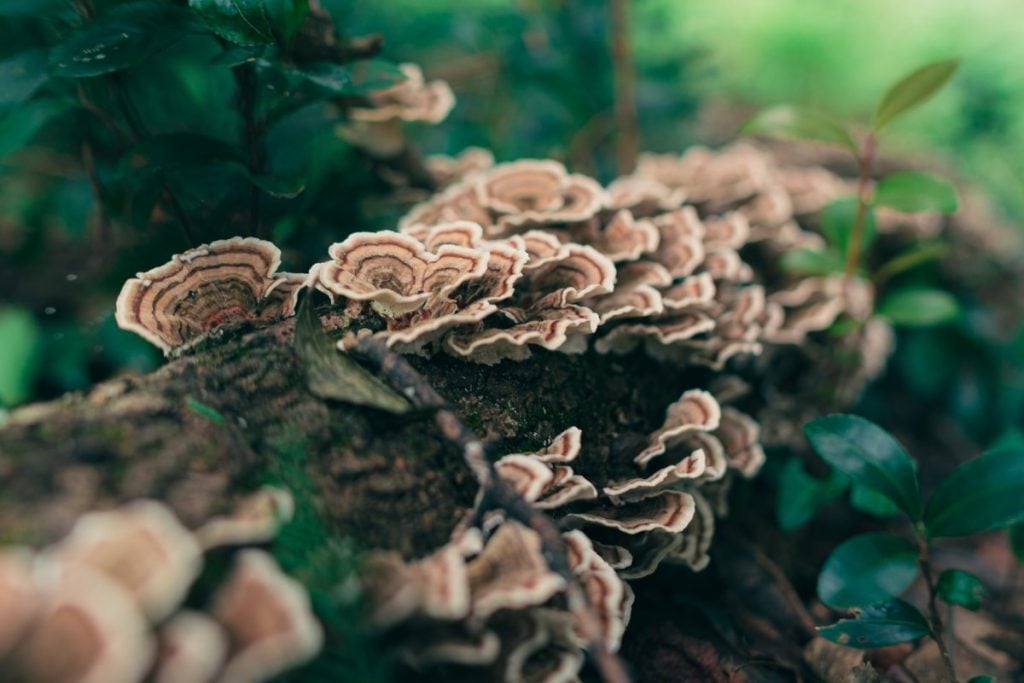
Where Do Turkey Tail Mushrooms Grow?
You can find turkey tail mushrooms almost anywhere in the world. They also grow year-round.
So they are really one of the easiest mushrooms to go out in the wild and find, no matter where you live. You can go out into pretty much any forest and find turkey tail mushrooms with a little luck.
When looking for turkey tails, pay special attention to hardwood trees. Look near the base of dead stumps, on the trunks of downed trees, or even on branches. Although turkey tails mostly grow on hardwood, you can sometimes find them on coniferous trees as well.
How To Find and Identify Turkey Tail Mushrooms
Turkey tail mushroom identification is straightforward compared to many other species of mushrooms.
Turkey tail mushrooms don’t have any known poisonous look-alikes. But that doesn’t mean you shouldn’t still try to positively identify them though.
You don’t want to go through all the work of collecting and preparing another type of mushroom that won’t provide the medicinal benefits that you’re looking for.
Here are some things to look for if you want to identify real turkey tail mushrooms.
Tiny Pores on the Underside
All turkey tail mushrooms will have tiny pores on the underside of their caps. When learning how to identify turkey tail mushrooms, this is the first thing you’ll want to look for.
You can immediately dismiss any mushrooms you find that have gills inside of pores. These are not turkey tails.
However, there are some look-alikes and related species that may also have pores. Most other species will have much larger pores than turkey tails though.
Genuine turkey tails will have three to eight pores per millimeter (1/25th of an inch.) These pores are extremely tiny and you may need to squint to see them.
Look-alike mushrooms will have larger pores. Only one to three of them within the same amount of space. If the pores are very large and easy to see, it’s probably not a turkey tail.
Fuzzy Surface
The cap of a turkey tail mushroom should have a fuzzy or velvety texture to it. It might even feel like it’s covered in fine hairs.
You can run your finger over the cap and see what the texture is like. If it feels fuzzy, then it’s most likely a turkey tail. If not, then it might be another look-alike species.
The fuzz may not be visible to the naked eye, but you should always be able to feel it. To see the fine texture on the cap with your eyes, you may need to use a magnifying glass.
Highly Contrasted Colors
The colors of a turkey tail mushroom form very high-contrast bands. The colors will immediately change from one to another. On other types of mushrooms, colors may form more of a gradient and fade from one color to another.
Young Caps Should Be Thin and Flexible
You should be able to bend a young turkey tail mushroom. It will be young and flexible. Other similar mushrooms will be rigid and hard even while they are young.
It’s worth noting that a rigid and hard mushroom does not necessarily mean it isn’t a turkey tail mushroom. As they get older and larger, turkey tails will become more rigid too. But young and small specimens should still be quite bendy.
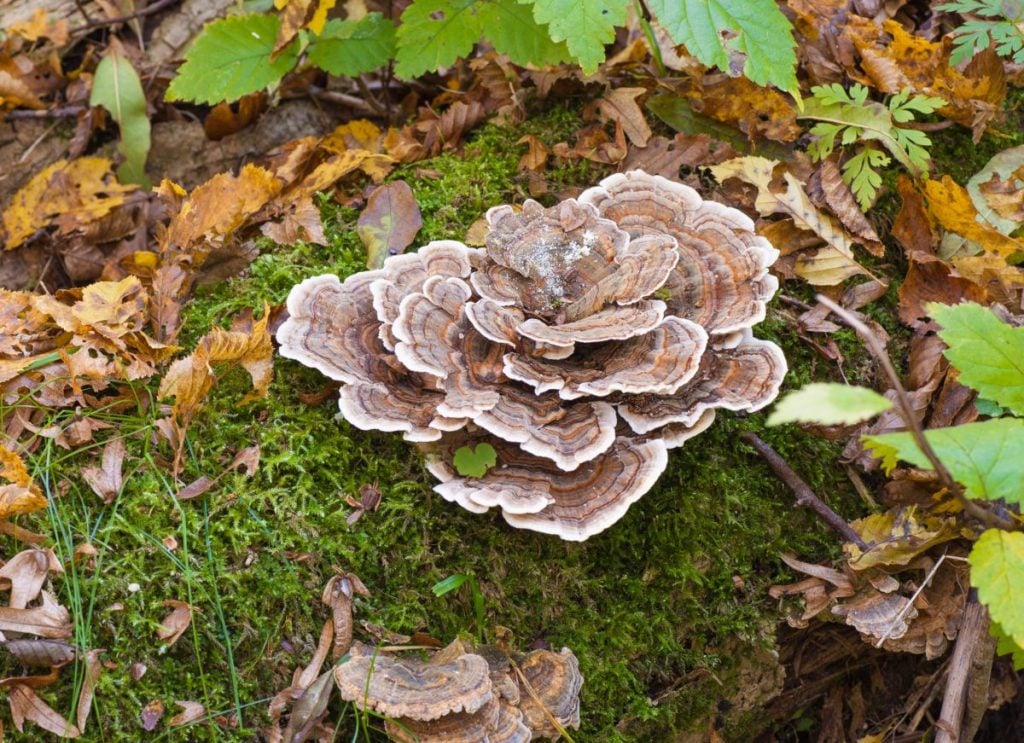
When Are Turkey Tail In Season?
Depending on your location, turkey tail mushrooms may be available all year round. It will depend on the weather conditions and climate of your area.
In the Northern hemisphere, turkey tails are most common between May and December. They are particularly prevalent in the autumn and winter when most turkey tails will be releasing their spores.
Types of Turkey Tail Mushrooms
Although turkey tail mushrooms are known by three separate scientific names, these all refer to the same common turkey tail mushroom.
You may notice large differences in appearance depending on the climate and type of wood that you find turkey tail mushrooms growing on. But in actuality, they are all the same kind of mushroom.
Turkey Tail Mushroom Look Alikes
Turkey tail mushrooms have several look-alikes. With a little bit of investigation, you should be able to easily sort out true turkey tails from their imposters using the information we shared above though.
Most of the false turkey tails that you will encounter will be other trametes species. In other words, mushrooms that are in the same family as the turkey tail.
Most of these other trametes mushrooms will have a more greyish appearance without the colored bands of a genuine turkey tail. The underside will also look different. Usually with larger and fewer pores.
Stereum ostrea is another mushroom species which is known as the false turkey tail. The caps of these mushrooms look very similar to those of turkey tails. However the underside is completely flat with no pores, which will quickly reveal that you’re not looking at a real turkey tail.
Other mushrooms like trichaptum abietinum or lenzites betulina also look like turkey tails upon first glance. But one look under the cap at their gills or tooth-like structure will let you know that they aren’t true turkey tails.
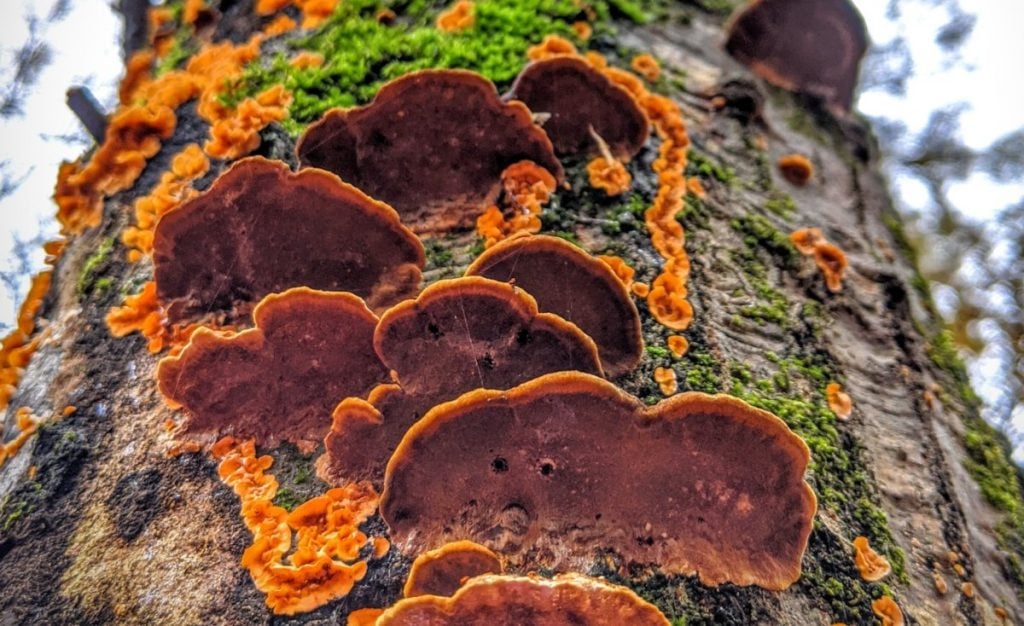
How to Harvest Turkey Tail
If you’re heading into the woods in search of turkey tail mushrooms, it’s best to bring a small sharp knife with you. This tool will help you to easily separate the mushrooms from tree trunks and logs.
Smaller mushrooms can simply be twisted off by hand.
How To Choose The Best Turkey Tail Mushrooms
You can harvest turkey tail mushrooms of all shapes and sizes for medicinal purposes. Smaller specimens will be more flexible and easy to harvest. But larger mushrooms don’t contain any less medicinal ingredients.
The main thing to look for when selecting turkey tail mushrooms is that there is no sign of insects. Worms and other small creatures like to eat mushrooms too. So make sure that any mushrooms you harvest are free of holes from worm, mold or any other imperfections.
How To Grow Turkey Tail at Home
Turkey tail mushrooms are quite easy to grow at home.
The easiest way to try growing them is to buy them as a kit. This way all you have to do is cut open the bag and keep them moist and turkey tail mushrooms will start to grow.
Alternatively you can buy sawdust or plug spawn and inoculate logs with them. The process is quite similar to growing shiitake mushrooms on logs.
See our article How To Grow Mushrooms On Logs: The Ultimate Guide for detailed step-by-step instructions on how to prepare and care for your turkey tail logs.
Hardwood logs will work best for growing turkey tails. But we have even heard of people having great success by growing turkey tails on recycled Christmas trees.
Turkey Tail Mushroom History and Fun Facts
Turkey tail mushrooms have been used in China for more than 1,000 years. Although it’s less popular in traditional Chinese medicine than reishi mushrooms, turkey tail mushrooms are still mentioned in writing back as far as 200 BC.
The turkey tail’s latin name versicolor refers to the wide variety of colors on the mushrooms’ cap.
Not everyone loves turkey tails! Some tree owners may worry about turkey tail mushrooms killing or damaging their trees. Removing the mushrooms can help the trees to survive.
Final Thoughts
Turkey tail mushrooms are too tough and woody to be edible. While you can’t add them to your pasta or other recipes, they are still a very useful mushroom.
They have many health benefits including lowering insulin resistance and boosting your immune system. They may even be able to help improve the effectiveness of some cancer treatments.
Best of all, turkey tail mushrooms are found almost everywhere. And they’re easy to identify. So if you’re interested in going mushroom hunting, turkey tails are a good first species to go looking for.
